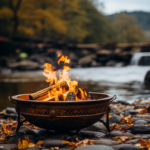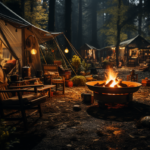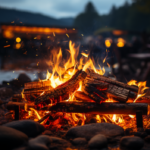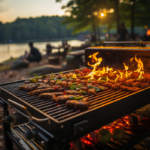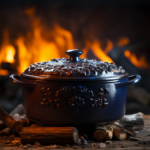Table of Contents
Essential Tips for Safe and Efficient Camp Cooking
Hey there nature lovers and outdoor adventurers! Are you gearing up for a camping trip and can’t wait to enjoy the great outdoors? Well, we’ve got you covered with some fantastic tips for safe and efficient camping cooking.
Cooking delicious meals while camping can be a fun and rewarding experience, but it’s important to prioritize safety and efficiency. With limited resources and potential hazards, it’s crucial to have some tricks up your sleeve to make your camp cooking experience a breeze.
In this guide, we’ll walk you through ten essential tips that will help you cook up a storm with peace of mind. From choosing the right cooking equipment to practicing proper food safety techniques, we’ve got all the hacks you’ll need to cook up tasty and safe meals in the wilderness.
We’ll share insights on setting up a safe cooking area, handling fire and fuel safely, and keeping your food fresh and unspoiled. We’ll also offer tips on simplifying your meals, maximizing your gear’s potential, and cleaning up efficiently after each cooking session.
So, whether you’re a seasoned camper or new to the camping scene, these tips will ensure that your camping cooking adventures are both safe and efficient. Let’s get cooking!
Choose the Right Cooking Equipment
When it comes to camping cooking, having the appropriate equipment can make all the difference. Here are some essential aspects to consider when selecting your cooking gear:
- Stove: Opt for a reliable camping stove that suits your needs. Look for one that is lightweight, compact, and easy to use. Gas stoves are a popular choice due to their efficiency and portability.
- Fuel: Depending on the stove you choose, you’ll need to determine the right type of fuel to bring along. Common options include propane, butane, and white gas. Consider the availability and cost of the fuel when making your decision.
- Cookware: Invest in durable and lightweight cookware specifically designed for camping. Look for pots, pans, and utensils made from materials like stainless steel or titanium. Non-stick coatings can also be convenient for easy cleaning.
- Grill or Campfire Grate: If you enjoy grilling, consider bringing a portable grill or campfire grate. These additions will allow you to cook delicious grilled meals over an open flame. Remember to check if your campsite permits open fires before using one.
- Cooler: Don’t forget to bring a high-quality cooler to keep your perishable food fresh. Look for a cooler with proper insulation and consider using ice packs or frozen water bottles to maximize its cooling capacity.
- Utensils and Cutlery: Pack a set of utensils and cutlery designed for camping. Ensure you have a knife, spatula, tongs, can opener, and other essentials. Opt for lightweight and compact options to save space.
Remember, each camping trip is unique, so consider the number of people, the duration of your stay, and the type of meals you plan to cook when selecting your cooking equipment. Being well-prepared with the right gear will contribute to a safe and efficient camping cooking experience.
No products found.
Set Up a Safe Cooking Area
Creating a safe cooking environment while camping is crucial to prevent accidents and ensure a smooth cooking experience. Here are some essential aspects to consider when setting up your cooking area:
- Location: Choose a flat and stable surface for your cooking area, away from flammable materials such as dry grass or tree branches. Placing your cooking station on a level ground will prevent pots and pans from tipping over.
- Ventilation: Ensure proper ventilation around your cooking area, especially if you’re using a gas stove. Setting up near open spaces or with good airflow will help dissipate any fumes and reduce the risk of carbon monoxide poisoning.
- Fire Safety: Have a fire extinguisher or a bucket of water nearby in case of emergencies. Clear any dry leaves or debris from the cooking area to minimize the risk of accidental fires. Always keep a watchful eye on open flames and never leave them unattended.
- Heat Source Placement: When using a portable stove or grill, place it on a stable surface that can handle the heat. Avoid placing it on a picnic table, as it can get damaged or cause a fire. Use a heat-resistant mat or a designated stove stand for added safety.
- Lighting: Ensure sufficient lighting in your cooking area, especially for nighttime cooking. Headlamps or lanterns can help illuminate your workspace, making it easier to handle utensils and cookware safely.
- Keep Children and Pets Away: If you’re camping with little ones or furry friends, establish boundaries around the cooking area. This will prevent accidental burns or injuries caused by interfering with hot surfaces or open flames.
By setting up a safe and well-planned cooking area, you’ll minimize the risk of accidents and ensure a safe cooking environment for you and your fellow campers. Remember, safety is paramount when it comes to enjoying your camping cooking adventures.
Practice Proper Food Safety Techniques
Food safety is crucial when camping to prevent foodborne illnesses and ensure a healthy and enjoyable trip. Here are some essential food safety techniques to keep in mind:
- Pack and Store Food Properly: Use airtight containers or resealable bags to store perishable items like meats, dairy products, and fruits. Keep them in a separate cooler with plenty of ice to maintain a safe temperature and minimize the risk of bacterial growth.
- Separate Raw and Cooked Foods: Avoid cross-contamination by using separate cutting boards and utensils for raw and cooked foods. Make sure to wash your hands thoroughly after handling raw meats.
- Cook Food to Safe Temperatures: Use a food thermometer to ensure that meats, poultry, and fish are cooked to the recommended internal temperatures. This will help kill any harmful bacteria that may be present. Refer to a food safety chart for specific temperature guidelines.
- Avoid Eating Undercooked Foods: While it’s tempting to enjoy a medium-rare steak or runny eggs, it’s safer to cook all foods thoroughly, especially when camping. Ensure meats are cooked all the way through and eggs are fully cooked to minimize the risk of foodborne illnesses.
- Clean as You Go: Maintain good hygiene by cleaning utensils, plates, and cooking surfaces as you cook. Use biodegradable soap and hot water to wash dishes and utensils, and sanitize them if possible. Dispose of food waste properly to prevent attracting pests.
- Wash Fruits and Vegetables: Rinse fresh produce with clean water, even if they’re pre-washed. This will help remove any dirt, bacteria, or pesticide residues that may be present.
By practicing proper food safety techniques, you’ll reduce the risk of foodborne illnesses and ensure that your camping meals are both safe and delicious. Remember, a little extra effort in food safety goes a long way towards a successful camping cooking experience.
Handle Fire and Fuel Safely
When cooking in the great outdoors, it’s important to handle fire and fuel with care to ensure your safety and that of your campsite. Here are some essential tips for handling fire and fuel safely:
- Choose the Right Fire Pit: If your campsite allows open fires, choose a designated fire pit or use an established fire ring. Clear any flammable materials around the pit, and make sure it’s a safe distance from tents and trees.
- Use Fire-Resistant Gloves: Invest in a pair of fire-resistant gloves to protect your hands when handling hot cookware or arranging firewood. These gloves will provide a barrier against burns and allow you to handle items safely.
- Keep Extinguishing Tools Nearby: Have a bucket of water, sand, or a fire extinguisher readily available in case you need to extinguish the fire quickly. Ensure everyone in your camping party knows its location and how to use it.
- Learn to Properly Start and Extinguish a Fire: Familiarize yourself with the proper techniques for starting and extinguishing a fire. Use long matches or a lighter to ignite the fire and gradually add dry kindling and firewood for a stable flame. When extinguishing, pour water or sand over the fire and stir to ensure it’s completely out.
- Handle Fuel Canisters with Care: If you’re using a camping stove that requires fuel canisters, handle them with caution. Keep them in an upright position, away from direct sunlight or heat sources. Follow the manufacturer’s instructions for safe handling and disposal.
- Store Fuel Safely: When not in use, store your fuel canisters in a cool and well-ventilated area, away from flames or sparks. Ensure caps are tightly sealed to prevent leakage or accidental ignition.
By following these tips, you’ll create a safer cooking environment and minimize the risk of accidents related to fire and fuel. Remember, safety should always be a top priority when enjoying the pleasures of camping cooking.
Keep Your Food Fresh and Unspoiled
One of the challenges of camping cooking is ensuring that your food stays fresh and safe to eat, especially when you’re away from refrigeration. Follow these essential tips to keep your food fresh and unspoiled during your camping trip:
- Plan Ahead: Before you leave for your camping adventure, plan your meals and pack only what you need. This will help reduce food waste and the risk of spoilage.
- Use Coolers: Invest in a high-quality cooler and pack it with ice or ice packs to keep perishable items cold. Place the cooler in a shaded area and avoid opening it frequently to maintain a consistent temperature.
- Separate Food: Keep raw meats, poultry, and seafood separate from ready-to-eat foods like fruits and vegetables. This reduces the risk of cross-contamination and potential foodborne illnesses.
- Pack Shelf-Stable Foods: Opt for shelf-stable foods such as canned goods, dried fruits, and nuts. These items don’t require refrigeration and can withstand the temperature variations during your trip.
- Freeze Food Beforehand: Freeze meats, pre-cooked meals, and other food items before your trip. This helps them stay fresh longer and acts as additional ice in your cooler. Make sure to thaw them thoroughly before cooking.
- Consider Dehydrated Meals: Dehydrated meals are a convenient option for camping. They are lightweight, easy to prepare, and have a long shelf life. Just add water, and you’ll have a tasty meal in no time.
- Properly Seal Food: Use resealable bags or airtight containers to store leftovers or prepped ingredients. This prevents exposure to air and keeps them fresh for longer periods.
Remember to always check the condition of your food and discard anything that shows signs of spoilage or has an off-putting smell. By following these tips, you can ensure that your camping meals are fresh, delicious, and safe to eat throughout your outdoor adventure.
No products found.
Simplify Your Meals
When it comes to camping cooking, simplicity is key. By simplifying your meals, you can save time, reduce the amount of equipment you need, and still enjoy delicious and satisfying food. Here are some essential tips for simplifying your camping meals:
- One-Pot Meals: Opt for one-pot meals that require minimal ingredients and cooking utensils. These meals not only save you time and effort but also result in fewer dishes to clean. Some examples include chili, pasta dishes, or stir-fry cooked in a single pot or skillet.
- Prep in Advance: Prepare ingredients before you leave for your camping trip. Chop vegetables, marinate meats, or portion out ingredients to make cooking easier and more efficient at the campsite.
- Stick to Staple Ingredients: Choose staple ingredients that are versatile and can be used in multiple dishes. For example, bring along items like rice, pasta, canned beans, and spices that can be used in different recipes.
- Buy Pre-Made: Consider buying pre-made or pre-packaged items that are suitable for camping. This could include pre-marinated meats, pre-chopped vegetables, or ready-to-eat items like trail mix or energy bars.
- Foil Packet Cooking: Embrace foil packet cooking, where you wrap your ingredients in aluminum foil and cook them over the fire or on the grill. This method locks in flavors, reduces clean-up, and allows for easy customization of individual meals.
- Utilize Foil and Skewers: Foil and skewers are versatile tools for easy camping cooking. Wrap marinated meats or vegetables in foil for a flavorful and mess-free cooking experience. Skewer ingredients like kebabs for a fun and effortless meal.
By simplifying your camping meals, you can spend less time and effort in the kitchen and more time enjoying the great outdoors. So, pack smart, choose simple yet delicious recipes, and simplify your cooking process for an efficient and enjoyable camping experience.
Maximize Your Gear’s Potential
When it comes to camping cooking, making the most of your gear is key to a successful and efficient experience. Here are some essential tips to help you maximize your gear’s potential:
- Multi-purpose Utensils: Invest in multi-purpose utensils to save space and reduce the number of items you need to bring along. Look for a spatula with a built-in bottle opener or a camping knife with various tool attachments.
- Use Your Campfire: If allowed at your campsite, utilize your campfire for cooking. Roast marshmallows for s’mores, cook foil-wrapped meals, or grill skewers directly over the flames. It’s a versatile and efficient way to prepare meals while enjoying the ambiance of the fire.
- Utilize Heat-Resistant Gloves: Heat-resistant gloves aren’t just for protection; they can also be used to handle hot pots, pans, and grates. With these gloves, you can safely move, flip, and adjust your cooking equipment without needing extra utensils.
- Dutch Oven Cooking: Take advantage of a Dutch oven to create a variety of delicious dishes. It can be used for baking, stewing, sautéing, and even deep-frying. The thick walls and cast iron construction allow for even heat distribution and excellent cooking results.
- Stackable Cookware: Opt for stackable or nesting cookware sets, where pots, pans, and lids fit together neatly. This saves space in your camping gear and makes it easier to transport and store.
- Utilize Natural Resources: Instead of using extra fuel or propane, consider utilizing natural resources in your cooking. For example, you can cook with small fallen branches or use rocks as a base for grilling. This approach not only saves fuel but also adds a unique outdoor flavor to your meals.
By maximizing the potential of your camping gear, you can reduce clutter, save space, and make your cooking process more efficient and enjoyable. So, get creative, think outside the box, and make the most of your camping cooking equipment.
Clean Up Efficiently
Cleaning up after a hearty meal is an essential part of camping cooking. Here are some tips to help you clean up efficiently and leave your campsite as you found it:
- Prepare a Washing Station: Set up a designated area for washing dishes and utensils. Fill a basin with warm, soapy water and another with clean water for rinsing. This makes the cleaning process more organized and efficient.
- Scrape and Wipe: Before washing, thoroughly scrape off food particles and wipe off any excess grease or dirt from your cookware. This reduces the amount of water and soap needed during cleaning.
- Use Biodegradable Soap: Use biodegradable dish soap to minimize any negative impact on the environment. Avoid using regular dishwashing liquid, as it may contain chemicals that could harm plants, water sources, or wildlife.
- Utilize Scrub Brushes and Sponges: Bring along scrub brushes and sponges specifically designed for camping. They are lightweight, compact, and durable enough to clean tough food residues without scratching your cookware.
- Dispose of Food Waste Properly: Pack out your food waste rather than leaving it behind. Double-bag it in a securely sealed plastic bag and store it in your trash bag to prevent attracting animals or causing litter.
- Leave No Trace: Abide by the principles of Leave No Trace by thoroughly cleaning your cooking area. Ensure there are no food scraps, trash, or other evidence of your presence left behind. Leaving a clean campsite helps preserve the beauty of nature for future campers.
Remember to always follow any specific guidelines or regulations provided by the campsite or park you’re staying at. By cleaning up efficiently, you not only maintain a safe and hygienic camping environment but also contribute to the sustainable enjoyment of the outdoors for all.
Conclusion
So there you have it, folks! These tips for safe and efficient camping cooking are sure to elevate your outdoor culinary adventures. By following these guidelines, you can have peace of mind knowing that you’re cooking safely, minimizing waste, and maximizing the fun.
From choosing the right cooking equipment to practicing proper food safety techniques, each aspect plays a significant role in ensuring a successful camping cooking experience. Remember to set up a safe cooking area, handle fire and fuel with care, and keep your food fresh and unspoiled.
Simplifying your meals and making the most of your camping gear will save you time and effort while still enjoying delicious meals in the great outdoors. And let’s not forget about cleaning up efficiently and leaving no trace, as it is our responsibility to preserve and respect the natural beauty of the environment.
So gather your camping gear, plan your meals, and get ready to create some amazing dishes under the open sky. Camping cooking is all about enjoying good food, connecting with nature, and making memories that will last a lifetime. Stay safe, have fun, and happy cooking!



